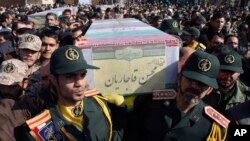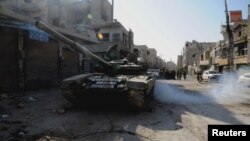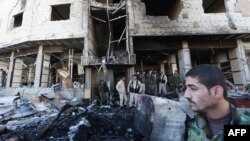Analysts and experts are expressing skepticism after an Iranian official said this week that more than 1,000 soldiers deployed by Iran have been killed since 2012 while aiding the Syrian regime in its civil war.
Mohammadali Shahidi Mahallati, head of Iran's Foundation of Martyrs and Veterans’ Affairs, did not elaborate on comments to the state-controlled Tasnim News Agency about the 1,000 dead. The number is a startling jump from four months ago, when the Islamic Republic put the figure at 400.
"The numbers could be an accumulation of all killed" including Afghans and Pakistanis fighting with Iran-allied forces and Lebanese Hezbollah, said Mohsen Shemirani, an Iranian scholar and political analyst in Tehran.
Iran has sent thousands of Afghans living in Iran, mainly ethnic Shi’ite Hazaras, to Syria to fight alongside forces of Hezbollah, and sent members of Iran's Revolutionary Guard Corps (IRGC) in support of Syrian government forces. Pakistani volunteers are also part of the forces. Hezbollah fighters from Lebanon are fighting alongside Iranians in separate units.
As Iran has increasingly made funerals of war dead public, many of the victims are Afghans and Pakistanis who do not have citizenship or resident status in Iran. They agree to fight in Syria in exchange for monetary benefits and rights for their families, experts say.
"Tehran allows authorities to grant citizenship to the families of Afghans and Pakistan nationals who are fighting in Syria against Sunni militants including the Islamic State," said Ali Alfoneh, a Washington-based international affairs expert and IRGC analyst.
Alfoneh, who daily tracks and monitors Iranian fatalities in Syria's war, said that even with the inclusion of noncitizen deaths, the Iranian numbers appear excessive.
"Iran's losses peaked in February 2016, as 61 Iranian nationals were killed in the suburbs of Aleppo," he said. "By comparison, in the course of the past six months, Iran suffered minor losses — 18 in June, five in July, five in August, nine in September, six in October and six in November."
Iran calls is fighters "Shrine Defenders" as Tehran says it is in Syria to protect the Zeinab Shrine in Damascus. Since 2011, Iran has been a major backer of the Syrian regime in its war with rebel groups across the country, at first sending advisers, then forces from its elite Revolutionary Guard.
Tehran was initially silent about its involvement in Syria, but in the last year has increasingly made its presence public to rally Iranians behind the cause. It has sent top officials to funerals, allowed news media to report on ceremonies, and promoted a military theme park for young people touting alleged accomplishments in Syria.
Iran, too, has added troops in Syria to include regiments of Iranian army volunteers. And experts say that has led to an uptick in the Iranian death toll — though likely not as high as Tehran advertises.
"The use of voluntary forces in war has always contributed to more casualties," said Daryoush Bourbour, a retired Iranian special forces commander who lives in the United States.
Iranian troops, too, have been increasingly drawn into the fight against Islamic State in Syria. IS is anti-Shi'ite and opposes Iranian involvement in Syria. It has used its propaganda tools to portray Iran as a top enemy.
"It is quite probable that the IS picks Iranians as their prime target," said Rasool Nafisi, a Middle East affairs expert in Washington.


